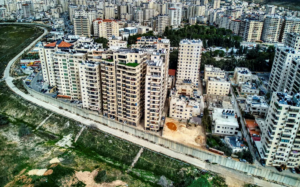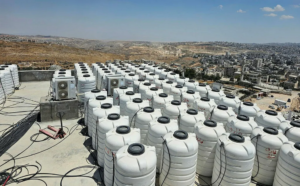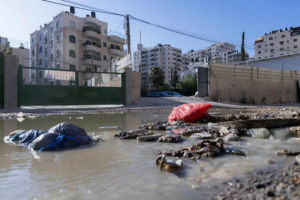Tens of thousands of Arabs live in East Jerusalem without running water: ‘It will become a second Gaza’

Kafr Akab and the West Bank separation barrier, 2023
Nir Hasson reports in Haaretz on 16 July 2024:
Amjad Shurrab, an employee of Al-Quds Maternity Hospital in East Jerusalem’s Kafr Aqab area, goes up to the roof of the building several times a day. Twenty-eight large water tanks are placed there, each with a capacity of 1,500 liters (400 gallons). Shurrab moves among them, shaking and banging on them to see how much water they contain. He climbs a ladder to peek inside, checking the complex system of pipes and pumps that supply water to the whole building.
“Water is a serious matter in a hospital,” says hospital director Taqi Qaissi. “We have to constantly check how much water is left. We now get water one or two days a week – but even then, there isn’t enough pressure in the pipes and the water can’t flow upward.”
Without a regular supply, the hospital has to spend thousands of shekels a week on water tankers to ensure that new mothers can shower after giving birth. Qaissi says various government agencies are aware of the crisis, including the Health Ministry and the Jerusalem Municipality, and that none have offered to assist.
There continues to be no running water in Kafr Aqab, a sprawling area in northern East Jerusalem with over 100,000 residents. A resident whose home has running water for more than one day a week is seen as lucky. Tens of thousands of others have water for only four to nine hours a week.
The situation, which has been ongoing for two months, is deteriorating. Those who had water for two days a week now have one day, and those who had a day now just have a few hours. The various relevant agencies are rolling the responsibility onto one another. These include the municipality; the Water Authority, the Israeli government’s regulating body; Mekorot, the national water company and Hagihon, the municipal water company. Residents are increasingly desperate. Things are getting worse, with one resident warning, “This place will become a second Gaza.”
The Kafr Aqab area was not always part of Jerusalem. In 1967, when East Jerusalem was annexed and the city’s map was redrawn, Qalandiyah Airport (later Atarot) was added to it. The ministers who approved the map envisioned Jerusalem as a capital city with a bustling international airport. Foreign airlines boycotted the airport, however, and it was eventually abandoned during the second intifada.
Including the airport in the city’s borders also entailed the annexation of Kafr Aqab, a small green village to its north. Until the West Bank separation barrier was built two decades ago, it remained a modest area surrounded by fields and orchards. The construction of the barrier cut it off from Jerusalem, and Israeli authorities withdrew and began to ignore it.
Over the next few years, Palestinians built high-rise buildings in the village to address the housing crisis faced by thousands of East Jerusalem families. For most of the time since then, the price of an apartment outside the barrier has been about one-sixth of the price of a similar apartment within the barrier in East Jerusalem.
In the last two decades, the village and the neighborhoods built around it have become the largest area in Jerusalem. In fact, in terms of the population, it is larger than most cities in Israel, with fewer than 20 of the country’s 80-plus cities being larger. None of the others has a hospital that has water for less than two days a week.
Officially, Kafr Aqab is part of Jerusalem, and most of its residents hold Israeli ID cards. Nevertheless, the authorities neglect the area almost completely. Many streets remain unpaved, and drainage systems collapse each winter, flooding homes and streets. There are no police or technicians or service providers. There is not a single playground or green space for the tens of thousands of children who live there.
Qaissi says that recently, the hospital was also out of phone and internet services for two weeks, and staff could only work using cell phones. Stray dogs roam the area in packs, and residents face poor infrastructure and living conditions. Their livelihoods depend on the Qalandiyah checkpoint, which they use to travel to work and education in the city. The road to the checkpoint is littered with burned concrete blocks, garbage and dust.
Despite all this, Kafr Aqab is not a miserable place. The dozens of high-rises built without permits are mostly well-maintained. The streets are full of various kinds of businesses, and many residents are middle-class and enjoy being between two large cities, Jerusalem and Ramallah.
Residents have established a community committee that administers the area, arbitrates disputes and pressures the authorities to address the myriad problems. A thriving community center operates in the village, where children learn to dance the dabke and adults learn Hebrew and music. It also has programs for seniors and people with disabilities.

Water tanks on a roof in Kafr Aqab, July 2024
Since the war in Gaza began, however, living conditions have been severely degraded. During the first few weeks after October 7, Israel kept the Qalandiyah checkpoint shut. Patients, schoolchildren, university students and workers found their gateway to the rest of Jerusalem blocked. The local economic situation declined. Members of the committee say some families got to the point where they lacked food.
Checkpoint has been open in recent months, but it now operates only partially and slowly. A huge traffic jam starts outside of it early in the morning and continues throughout the day until the evening. “If you start work at 8 A.M., you leave at 5 A.M.,” says village council chairman Samer Abu Khalaf. “Schoolchildren cross the checkpoint and sleep in the car for three hours. Have you ever seen anything like that?”
Bus companies have greatly reduced their service because of the situation at the checkpoint, further exacerbating the situation. Some residents tried to bypass the checkpoint by entering Jerusalem from the Hizma checkpoint, which is used by the Israeli settlers living north of the city. They discovered that the military had set up a new checkpoint designed to prevent them from reaching the Hizma checkpoint and to allow settlers to enter Jerusalem without being stuck in traffic.
All these challenges pale in comparison to the lack of water, however. Over the years, residents have gotten used to the fact that water doesn’t flow 24/7, so the roofs of the buildings in the area are covered with huge water tanks to guarantee a supply when the pipes are empty. Almost every family has two tanks and an electric pump to deal with low pressure and raise water from underground reservoirs. The reason for the shortage is that, unlike all other parts of Jerusalem, Kafr Aqab isn’t supplied by the municipal water corporation, Gihon, but rather by the Palestinian Water Authority, which buys water from Mekorot and distributes it.
For years, residents and public representatives in the area have warned of the danger posed by the tanks. A simple calculation shows that the two 1,500-liter tanks often found on the roof of a building means there are more than 100 tons of water above the heads of dozens of families. Given that almost all construction in the village is done without permits and oversight, it would take only one contractor to pay insufficient attention to the concrete on the roof for a disaster to occur.
Until recently, the system of tanks and pumps set up by residents had managed the partial water supply quite successfully. The past two months have seen a substantial change. “Even in the poorest country in the world, you won’t see things like this,” says Abu Khalaf. “If there are problems in Gaza or Lebanon, why do we have to be punished?”
To deal with the shortage, residents have started purchasing water from tankers operated by independent entrepreneurs. They suspect the water in the tankers has been purchased from nearby settlements but have no proof. Three thousand liters filling two large containers cost 300-350 shekels ($85-95), depending on the height of the building. Most residents who spoke with Haaretz said they refilled the containers at least once a week – and even then, they have to place restrictions on family members and enforce water discipline.
Not coping
The crisis is severely disrupting life in the area. Schools have canceled summer camps and patients are being transferred to hospitals inside Jerusalem for fear of a water shortage. The impact is felt the most in daily life, with residents avoiding showers, washing floors, running washing machines and even flushing toilets.
“Once every three or four times, the water gets turned off. The house stinks, but what can we do?” says one of the residents. “Don’t ask how we’re getting by. We’re not getting by. Just not getting by.”

Kafr Aqab, July 2024
Water can be found in the streets in the form of sewage puddles. According to the residents, the crew responsible for unclogging sewers works only some of the time because it also needs water to operate the equipment.
In recent weeks, the community committee has tried to get a clear answer as to who is responsible for the lack of water, but to no avail. The Palestinian Water Authority, the area’s water supplier, says Israel has reduced the supply for the area. Mekorot, which sells the water to the Palestinian Authority, denies that the quantity has been reduced and points to the Israeli Water Authority.
The Israeli Water Authority says it instructed Mekorot to search for solutions in the area, but that infrastructure development is expected to take about two years. In response to a request from the Association for Civil Rights in Israel, the Water Authority also placed some responsibility on its Palestinian counterpart, which, it says, failed to conduct “water harvesting… that would help improve the supply situation in the neighborhood.”
The Jerusalem Municipality puts the responsibility to the Palestinian Authority and says that the best solution would be to connect the area to the Gihon municipal water system. However, such a move would take years become complicated because of the area’s unauthorized construction.
No permit to protest
While the authorities kick the ball over to one another, thirst has become a part of daily life in Kafr Aqab. Desperate residents have protested twice in front of the Palestinian Water Authority offices in the past couple of weeks,. They also wanted to protest in front of the Jerusalem Municipality, but the police told them they would not receive a permit.
Older residents all expressed a deep sense of helplessness. “Yesterday, I fought with my wife, who wanted to do laundry,” one of them says. Another says, “I get 3,500 shekels from the National Insurance Institute each month, and 1,000 shekels of that I spend just on water. I have to get water for the family.”
“Last week, my wife went to her family’s house because we didn’t have water,” says a third. “I flush the toilet using bottles.” A fourth adds, “If you have children, it’s a serious problem. You need water for drinking, for bathing. Without water, there is no life.”
Two weeks ago, a large water pipe burst in the Jewish neighborhood of Ein Kerem on the other side of the city. Gihon workers operated on emergency footing and restored the water supply to the area within a few hours. The next day, however, there were disruptions in the water supply to the community center in the area. The Jerusalem Municipality’s spokesperson released four public notices that day, going so far as to assure the concerned Jerusalem public that “the Gihon Corporation is ensuring the provision of water by alternative means” for community center visitors.
By contrast, the water crisis in Kafr Aqab has not been publicly addressed by Jerusalem Mayor Moshe Lion or the municipality, despite repeated appeals from residents, local officials and journalists. When asked privately, Lion said the matter was not within his jurisdiction. Similar responses were received from Gihon and Mekorot. Abu Khalaf says the residents have tried everything. “We are knocking on all the doors, but none of them opens,” he says.
The Water Authority said in response to a request for comment: “The supply in the Kafr Aqab neighborhood is managed by the Ramallah Water Company. The supply comes from connections that also serve other consumers in the Palestinian Authority, and the decision regarding the quantities directed to these villages or other consumers is in the hands of the Ramallah Water Company.
“The Water Authority has long approved the development of infrastructure to increase the overall amount supplied to this area and it is expected to be completed by 2026. This is an area with extensive unregulated construction, and under such circumstances, there is, by necessity, a disparity in the ability to supply the appropriate quantities of water for the continued population growth. The law prohibits supplying water to illegal buildings, but the Water Authority continues its efforts to increase the overall amount flowing to the area as quickly as possible.”
The Jerusalem Municipality said in response to a request for comment: “Jerusalem Mayor Moshe Lion has instructed professional experts to delve into the matter with the aim of reaching a solution to ensure the regular water supply to the residents of the Kafr Aqab neighborhood. He did it even though the issue is not within the municipality’s responsibility, and the issue stems from the irresponsible conduct of the Palestinian Authority, which is responsible for supplying the water in the neighborhood, according to diplomatic agreements.
“There are two proposed solutions: upgrading Mekorot’s existing systems or establishing new infrastructure and putting the area under Gihon’s scope of responsibility,” it continues. “While the second option may take many years and encounter legal obstacles due to the widespread illegal construction in the neighborhood, it was recommended to further promote the upgrading of Mekorot’s existing systems (which is itself also a process of months to years).”
This article is reproduced in its entirety
